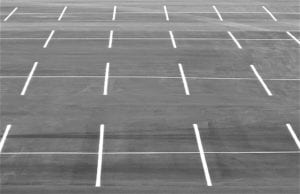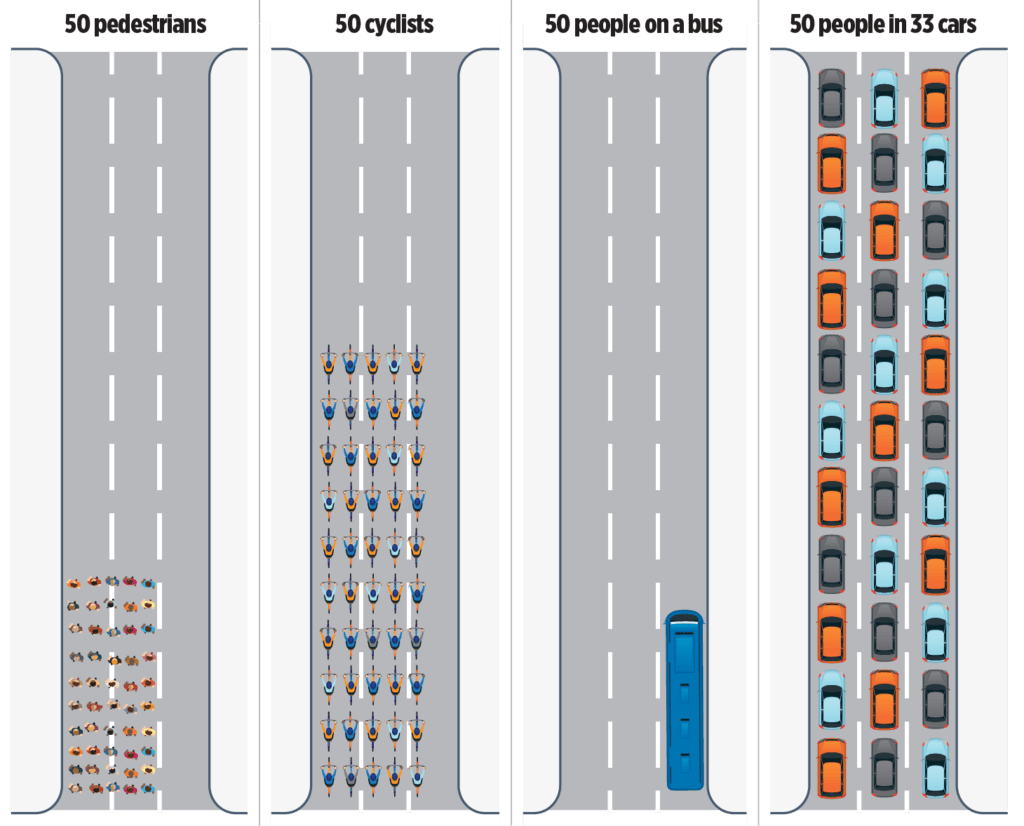When weary soldiers returned home following WWII, Uncle Sam was pleased to extend a welcoming hand. The creation of the Federal Housing Administration and the passing of the G.I. Bill enabled veterans to acquire low-interest mortgages with small down payments. Population growth and the roaring war-tuned manufacturing industry created a huge demand for homeownership as the middle class grew. The Interstate Highway System was built, and the proliferation of zoning laws restricted density and promoted sprawl. Flourishing families in unsanitary and crowded cities saw an opportunity to have more space at a reasonable price – all they needed was means of fleeing to the burgeoning suburbs. The car served as that means of escape from the noise and chaos of public life and gave the freedom of travel to anywhere.
Car culture has been established as dominant through decades of consumer trends and political movements. Now it is inextricably linked to the almighty American sentiment of rugged individualism, in which we operate with a perception of full autonomy and with little regard for our neighbors. Legislation indirectly subsidizing car usage persists today, ensuring that the automobile serves as the primary mode of transportation in the U.S.
First, many costs that should be associated with road usage – such as costs of construction, maintenance, and operation – are instead distributed evenly across the general taxpayer populace. Rather than being based on how often one uses a car, these particular expenses fall equally on both those who are spending eight or more hours driving daily and the more than one-hundred million Americans who do not have a driver’s license. Distributing such road usage costs over all Americans thus acts as a subsidy for cars by reducing the relative cost of automobile ownership.
Next, restrictive zoning limits dense development and necessitates sprawl. When low density is enforced, public transit ridership cannot be as high as it ought to be and becomes impractical. Instead, the resulting wide distances between population hubs and commercial centers makes the car a necessity. In an effort to satisfy perceived demand, zoning has also mandated the creation of massive amounts of parking in our urban areas. Parking comes at the expense of green land, open space, or other more productive uses. Approximately 14% of Los Angeles County’s total land area is currently dedicated to parking. As many as 2 billion parking spots exist for the 250 million cars in the United States.

Additionally, on-street parking is often free to use and reserved exclusively for car usage. Unlike other public services, one does not have to be a resident of a municipality to benefit from such parking. Free parking generates higher demand for private vehicles than would otherwise exist. In short, all these political and regulatory decisions combine to lower the relative costs of car ownership. Households are encouraged to become more dependent on cars, and car-centered planning is thus rationalized.
If the benefits of car culture outweigh the costs, then the subsidies which cars receive would be sensible. Unfortunately, when we choose a car-dominated world, we subject ourselves to several negative side-effects that exceed the benefits of convenience. Traffic and urban sprawl create congested cities, collectively wasting hours and hours of time as we wait. This issue is partly due to private vehicles occupying so much space in comparison with other modes of transportation:

Suburbanization also leads to a loss of vitality in urban centers. Once bustling downtowns no longer have denizens walking around as people simply get in their car and go all the way from point A to point B. There is a resultant dearth of interaction between diverse groups of people, preventing knowledge sharing, encouraging a stratification of society, and contributing to a feeling of disconnection from one another.
Cars contribute to killing our planet via pollution, non-renewable fuel consumption, and climate change. They are one of the leading sources of greenhouse gas emissions in the U.S. Indeed, no public transportation is energy free. But, for instance, a ride with New York City’s MTA emits a tenth of the carbon dioxide that the average trip in a car does. The frequency and carelessness with which we utilize cars is irresponsible to our environment.
Lastly and perhaps most reprehensibly, cars simply hurt us. Indirectly, sedentary lifestyles have contributed to high obesity rates in the United States. Women and men in rural areas are 24% and 33% more likely to be obese than their city-dwelling counterparts, respectively. More directly, over 40,000 traffic deaths occur per year in the U.S. alone, as well as countless injuries.
Thus, I am urging us to reconsider our dependency on cars and to improve our health, safety, and quality of life. Our political leaders can make several changes right now to both benefit Americans and set an example to the rest of the world, as many countries currently seem to be following the American model of heavy car usage as industrialization occurs.
The most immediately apparent solution is greater public transport subsidies. Since public transit is truly public – one does not require a driver’s license to take a bus – it makes more sense to spread the cost of the service to the general taxpayer that it does to spread road costs to the general taxpayer. Rather than being viewed in a lens of profitability, public transportation should be perceived as serving the common interest, akin to public universities or libraries. Additionally, increasing subsidies for public transit is sensible as the fare for users per trip has increased over time relative to income, whereas the relative cost of car usage has decreased.
A second option is revising land use regulation, especially in urban areas, to encourage higher density dwelling, to deemphasize parking space, and to regulate speed more strictly (via speed limits, speed bumps, and extended curbs). Such changes would gradually make urban areas more pedestrian-friendly and make car usage unnecessary. Focusing on pedestrians in development and land use could help realize the ’15-minute city’, an urban planning model where everything that residents need, from housing to venues, stores, offices, and parks, is within 15 minutes on foot.
Simple alternatives exist for cities wanting to reduce congestion. Local authorities can partner with companies such as VIA Transportation, a ride-share service offering demand-responsive carpooling. Government can also promote bike usage by reserving existing car lanes for cyclists only, as Mayor de Blasio has recently done on both the Brooklyn and Queensboro Bridges. Additionally, the rise of autonomous vehicles will serve a great benefit by reducing parking demand, easing congestion, and perhaps discouraging car ownership completely.
Finally, taxes can be implemented that appropriately charge cars for the costs they induce. A carbon tax, applied to gasoline prices, would reduce demand for cars and incentivize alternative energy options. Demand-responsive pricing for parking spots and highways would appropriately tax cars for causing excessive congestion. In 2011, after incorporating demand-responsive pricing in certain areas of San Francisco, the city noticed a rise in sales tax revenue, a reduction in average meter rates, and a 30% decrease in vehicle miles traveled.
A car-dominated future is not guaranteed if policymakers are willing to courageously veer away from car culture. If we build our public policy to emphasize the pedestrian, a greener and safer future is achievable.
About the author: Andrew is a graduate student at NYU SPS Schack Institute of Real Estate. He is pursuing a Master’s in Real Estate and has a background in structural engineering. He is dedicated to improving our built environment and aspires to bring energy and creativity to the New York Real Estate industry.
SOURCES
- Bliss, L. (2018, November 27th). America probably has enough parking spaces for multiple Black Fridays. Bloomberg. https://www.bloomberg.com/news/articles/2018-11-27/why-parking-lots-are-not-full-even-on-black-friday
- Florida, R. (2018, July 24th). Parking Has Eaten American Cities. Bloomberg. https://www.bloomberg.com/news/articles/2018-07-24/the-overparked-states-of-america (Photo by Jae C. Hong)
- Fitzsimmons, E.G. and Winnie, H. (2021, January 28th). Car lanes to become bike lanes on 2 major New York City bridges. New York Times. https://www.nytimes.com/2021/01/28/nyregion/bike-brooklyn-bridge-de-blasio.html
- Glaeser, E. (2011). The Triumph of the City. Penguin Books. p. 207-208.
- Glover, E. (2020, March 30th). Ride-hailing startup Via raises $200M. BuiltinNYC. https://www.builtinnyc.com/2020/03/30/via-raises-200m
- Jose, B. (2017, December 5th). San Francisco adopts demand-responsive pricing program to make parking easier. SFMTA. https://www.sfmta.com/blog/san-francisco-adopts-demand-responsive-pricing-program-make-parking-easier
- Lardieri, A. (2018, June 20th). Obesity more prevalent in rural areas. USNews. https://www.usnews.com/news/health-care-news/articles/2018-06-20/obesity-rates-higher-in-rural-areas-than-cities
- Laughlin, J. (2019, January 29th). Why is Philly stuck in traffic? Philadelphia Inquirer. https://www.inquirer.com/transportation/inq/traffic-philadelphia-center-city-bike-lanes-subway-bus-transit-solutions-20190129.html (Photo by Jared Whalen)
- Shill, G.H. (May 2020). Should law subsidize driving? New York University Law Review. 27(2), 498-579. https://www.nyulawreview.org/wp-content/uploads/2020/05/NYULAWREVIEW-95-2-Shill.pdf
- Yeung, P. (2021, January 4). How ’15-minute cities’ will change the way we socialise. BBC. https://www.bbc.com/worklife/article/20201214-how-15-minute-cities-will-change-the-way-we-socialise
Well done Andrew! This article on strategic design explores the period at the beginning of the pandemic when cities and states were initially enacting stay-at-home orders. The once-packed urban streets became empty… no cars! Some mayors seized this opportunity. The aftermath of the COVID-19 pandemic could allow cities to rethink transit and infrastructure more broadly, and the popularity of car-free streets in some cities could raise their profile.